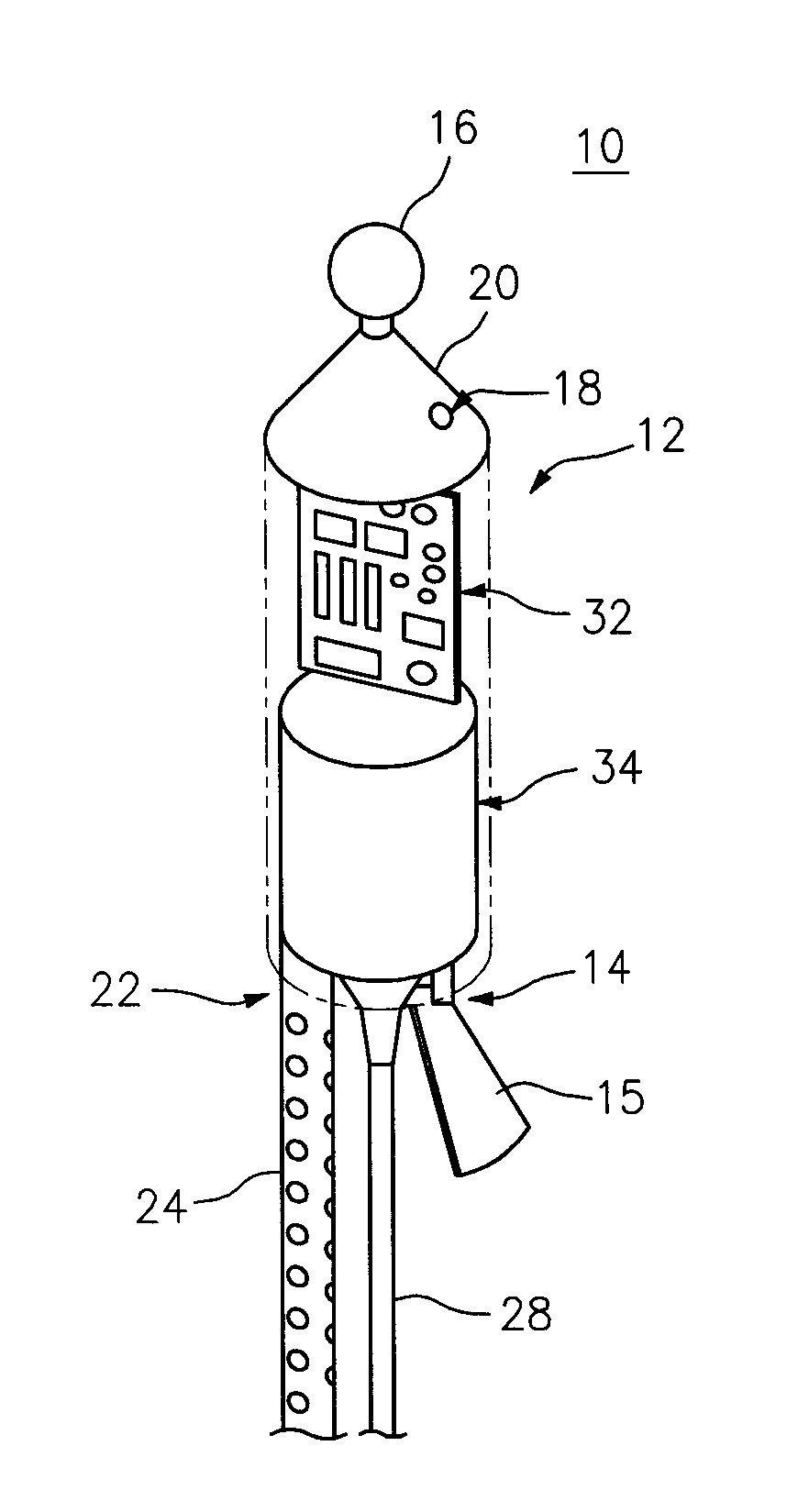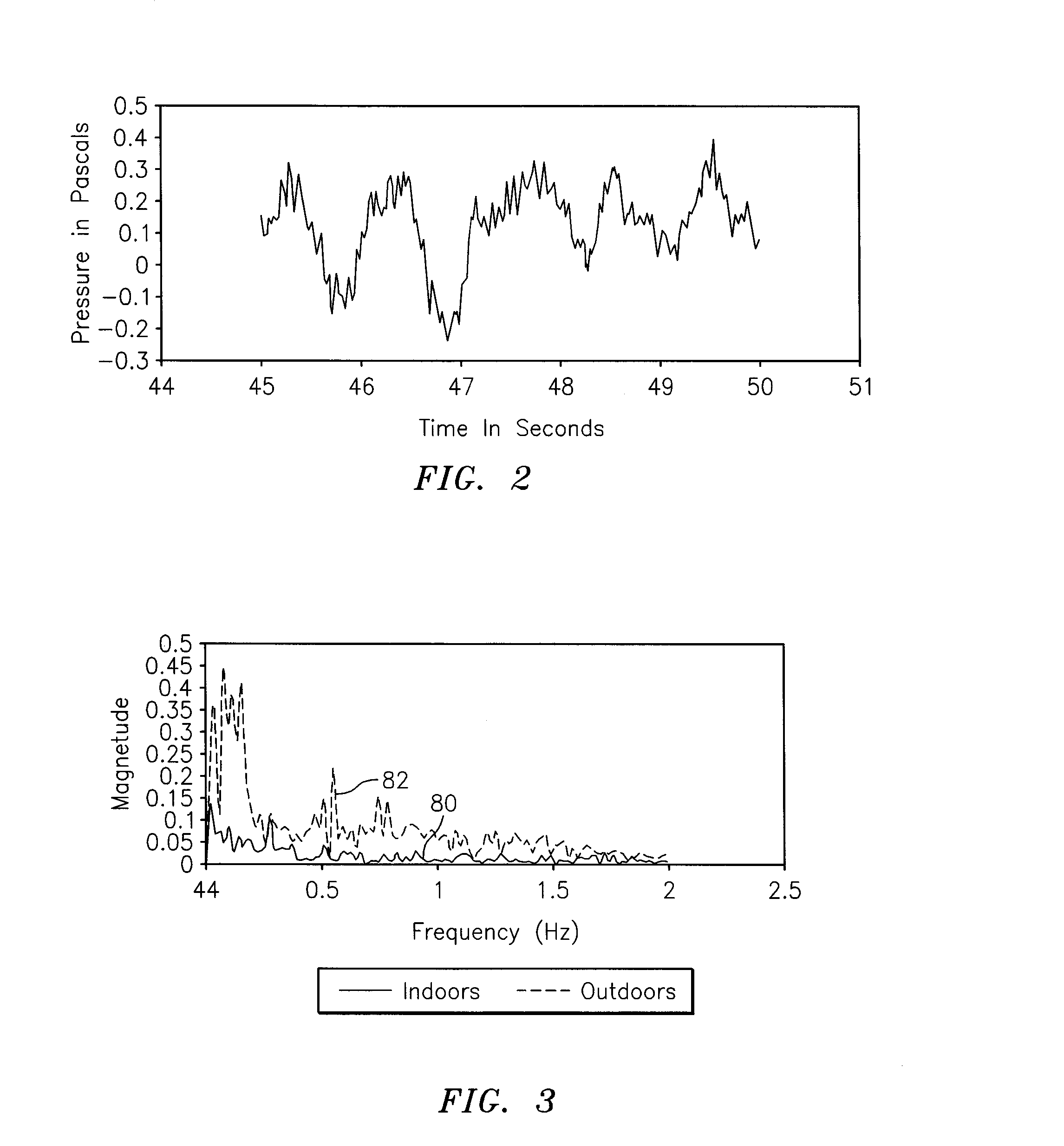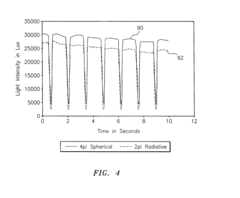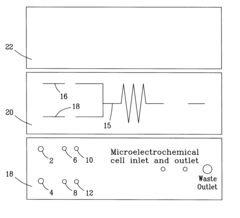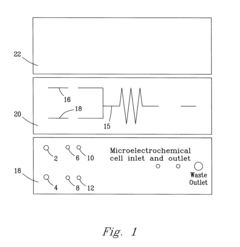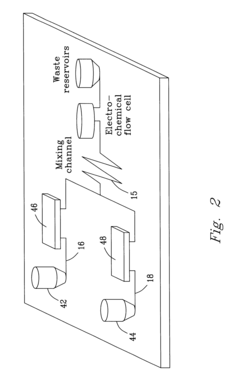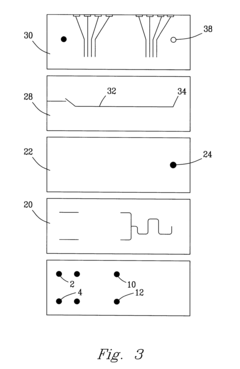The Role of Silicon Micropillars in Environmental Monitoring
JUL 9, 20259 MIN READ
Generate Your Research Report Instantly with AI Agent
Patsnap Eureka helps you evaluate technical feasibility & market potential.
Silicon Micropillar Background and Objectives
Silicon micropillars have emerged as a promising technology in the field of environmental monitoring, offering unique capabilities for detecting and analyzing various environmental parameters. The development of these microscale structures has its roots in the broader field of microelectromechanical systems (MEMS) and nanotechnology, which have seen significant advancements over the past few decades.
The evolution of silicon micropillars can be traced back to the early 2000s when researchers began exploring the potential of micro- and nanostructures for sensing applications. Initially, these structures were primarily investigated for their optical properties and potential use in photonics. However, as fabrication techniques improved and the understanding of material properties at the microscale deepened, the scope of applications expanded to include environmental sensing.
The primary objective of silicon micropillars in environmental monitoring is to provide highly sensitive, selective, and reliable detection of various environmental pollutants and parameters. These structures offer several advantages over traditional sensing methods, including increased surface area-to-volume ratio, enhanced light interaction, and the ability to be functionalized with specific chemical or biological receptors.
One of the key drivers behind the development of silicon micropillar technology for environmental monitoring has been the growing need for real-time, in-situ sensing capabilities. As environmental concerns have become more pressing, there is an increasing demand for monitoring systems that can provide accurate and timely data on air and water quality, greenhouse gas emissions, and other environmental indicators.
The technical goals for silicon micropillars in environmental monitoring encompass several aspects. Firstly, there is a focus on improving the sensitivity and selectivity of these structures to detect ever-lower concentrations of pollutants and distinguish between similar compounds. Secondly, researchers aim to develop robust and durable micropillar arrays that can withstand harsh environmental conditions and provide long-term stability in field deployments.
Another important objective is the integration of silicon micropillars with other sensing technologies and data processing systems to create comprehensive environmental monitoring platforms. This includes the development of miniaturized, low-power devices that can be deployed in large numbers for distributed sensing networks.
As the technology continues to evolve, there is also a growing emphasis on exploring new materials and fabrication techniques to enhance the performance and reduce the cost of silicon micropillar-based sensors. This includes investigating hybrid structures that combine silicon with other materials to achieve specific sensing properties or improve overall device performance.
In conclusion, silicon micropillars represent a significant technological advancement in the field of environmental monitoring, with the potential to revolutionize how we detect and measure environmental parameters. The ongoing research and development in this area aim to address the pressing need for more accurate, sensitive, and widespread environmental monitoring capabilities to support global efforts in environmental protection and sustainable development.
The evolution of silicon micropillars can be traced back to the early 2000s when researchers began exploring the potential of micro- and nanostructures for sensing applications. Initially, these structures were primarily investigated for their optical properties and potential use in photonics. However, as fabrication techniques improved and the understanding of material properties at the microscale deepened, the scope of applications expanded to include environmental sensing.
The primary objective of silicon micropillars in environmental monitoring is to provide highly sensitive, selective, and reliable detection of various environmental pollutants and parameters. These structures offer several advantages over traditional sensing methods, including increased surface area-to-volume ratio, enhanced light interaction, and the ability to be functionalized with specific chemical or biological receptors.
One of the key drivers behind the development of silicon micropillar technology for environmental monitoring has been the growing need for real-time, in-situ sensing capabilities. As environmental concerns have become more pressing, there is an increasing demand for monitoring systems that can provide accurate and timely data on air and water quality, greenhouse gas emissions, and other environmental indicators.
The technical goals for silicon micropillars in environmental monitoring encompass several aspects. Firstly, there is a focus on improving the sensitivity and selectivity of these structures to detect ever-lower concentrations of pollutants and distinguish between similar compounds. Secondly, researchers aim to develop robust and durable micropillar arrays that can withstand harsh environmental conditions and provide long-term stability in field deployments.
Another important objective is the integration of silicon micropillars with other sensing technologies and data processing systems to create comprehensive environmental monitoring platforms. This includes the development of miniaturized, low-power devices that can be deployed in large numbers for distributed sensing networks.
As the technology continues to evolve, there is also a growing emphasis on exploring new materials and fabrication techniques to enhance the performance and reduce the cost of silicon micropillar-based sensors. This includes investigating hybrid structures that combine silicon with other materials to achieve specific sensing properties or improve overall device performance.
In conclusion, silicon micropillars represent a significant technological advancement in the field of environmental monitoring, with the potential to revolutionize how we detect and measure environmental parameters. The ongoing research and development in this area aim to address the pressing need for more accurate, sensitive, and widespread environmental monitoring capabilities to support global efforts in environmental protection and sustainable development.
Environmental Monitoring Market Analysis
The environmental monitoring market has experienced significant growth in recent years, driven by increasing awareness of environmental issues, stringent regulations, and technological advancements. The global market for environmental monitoring solutions is expected to continue its upward trajectory, with a particular focus on air and water quality monitoring.
In the context of silicon micropillars for environmental monitoring, the market shows promising potential. These innovative structures offer enhanced sensitivity and selectivity in detecting various environmental pollutants, making them particularly valuable in urban areas and industrial zones where precise monitoring is crucial. The demand for such advanced sensing technologies is rising as governments and organizations worldwide strive to meet increasingly stringent environmental standards.
The water quality monitoring segment represents a substantial portion of the environmental monitoring market. Silicon micropillars have shown great promise in this area, particularly for detecting trace amounts of contaminants in water sources. This capability is especially relevant in regions facing water scarcity and pollution challenges, driving the adoption of advanced monitoring technologies.
Air quality monitoring is another key segment where silicon micropillars are making an impact. With growing concerns over urban air pollution and its health effects, there is a strong demand for more accurate and real-time air quality monitoring systems. Silicon micropillars' ability to detect fine particulate matter and gaseous pollutants at low concentrations positions them as a valuable tool in this market segment.
The industrial sector is a significant driver of the environmental monitoring market, with companies seeking to comply with regulations and improve their environmental performance. Silicon micropillars offer the potential for more efficient and cost-effective monitoring solutions in industrial settings, particularly in emissions control and waste management applications.
Emerging markets, particularly in Asia-Pacific and Latin America, present substantial growth opportunities for environmental monitoring technologies. Rapid industrialization and urbanization in these regions have led to increased environmental concerns, prompting governments to implement stricter monitoring and control measures. This trend is expected to boost the demand for advanced sensing technologies like silicon micropillars.
The integration of silicon micropillars with Internet of Things (IoT) and big data analytics is opening new avenues in the environmental monitoring market. This combination enables the creation of smart environmental monitoring networks, offering real-time data collection and analysis capabilities. Such integrated solutions are increasingly sought after by smart cities and environmental management agencies, further expanding the market potential for silicon micropillar-based technologies.
In the context of silicon micropillars for environmental monitoring, the market shows promising potential. These innovative structures offer enhanced sensitivity and selectivity in detecting various environmental pollutants, making them particularly valuable in urban areas and industrial zones where precise monitoring is crucial. The demand for such advanced sensing technologies is rising as governments and organizations worldwide strive to meet increasingly stringent environmental standards.
The water quality monitoring segment represents a substantial portion of the environmental monitoring market. Silicon micropillars have shown great promise in this area, particularly for detecting trace amounts of contaminants in water sources. This capability is especially relevant in regions facing water scarcity and pollution challenges, driving the adoption of advanced monitoring technologies.
Air quality monitoring is another key segment where silicon micropillars are making an impact. With growing concerns over urban air pollution and its health effects, there is a strong demand for more accurate and real-time air quality monitoring systems. Silicon micropillars' ability to detect fine particulate matter and gaseous pollutants at low concentrations positions them as a valuable tool in this market segment.
The industrial sector is a significant driver of the environmental monitoring market, with companies seeking to comply with regulations and improve their environmental performance. Silicon micropillars offer the potential for more efficient and cost-effective monitoring solutions in industrial settings, particularly in emissions control and waste management applications.
Emerging markets, particularly in Asia-Pacific and Latin America, present substantial growth opportunities for environmental monitoring technologies. Rapid industrialization and urbanization in these regions have led to increased environmental concerns, prompting governments to implement stricter monitoring and control measures. This trend is expected to boost the demand for advanced sensing technologies like silicon micropillars.
The integration of silicon micropillars with Internet of Things (IoT) and big data analytics is opening new avenues in the environmental monitoring market. This combination enables the creation of smart environmental monitoring networks, offering real-time data collection and analysis capabilities. Such integrated solutions are increasingly sought after by smart cities and environmental management agencies, further expanding the market potential for silicon micropillar-based technologies.
Current Challenges in Micropillar Sensor Technology
Silicon micropillar sensor technology, while promising for environmental monitoring, faces several significant challenges that hinder its widespread adoption and optimal performance. One of the primary obstacles is the complexity of fabrication processes. Creating uniform, high-aspect-ratio micropillars with consistent properties across large areas remains a technical hurdle. This challenge is compounded by the need for precise control over pillar dimensions, spacing, and surface chemistry, all of which significantly influence sensor sensitivity and selectivity.
Another critical challenge lies in the integration of micropillar sensors with readout electronics and data processing systems. The miniaturization of these components while maintaining high performance and reliability is a complex task. Furthermore, ensuring robust electrical connections between the micropillars and the underlying circuitry without compromising the sensor's structural integrity or sensing capabilities presents additional difficulties.
Durability and long-term stability of micropillar sensors in harsh environmental conditions pose another set of challenges. Exposure to varying temperatures, humidity levels, and potentially corrosive substances can degrade sensor performance over time. Developing protective coatings or encapsulation methods that do not interfere with the sensor's functionality is crucial for real-world applications.
Selectivity in complex environmental matrices is a persistent issue for micropillar sensors. While these sensors can be highly sensitive, distinguishing between similar analytes or detecting specific compounds in the presence of interfering substances remains challenging. This problem is particularly acute in environmental monitoring, where target analytes may be present in trace amounts amidst a complex mixture of other compounds.
Scalability and cost-effectiveness present additional hurdles. Transitioning from laboratory-scale production to large-scale manufacturing while maintaining quality and performance is a significant challenge. The current fabrication methods often involve expensive equipment and materials, making widespread deployment economically unfeasible for many applications.
Lastly, standardization and calibration of micropillar sensors for environmental monitoring applications are ongoing challenges. Developing reliable calibration protocols that account for variations in environmental conditions and sensor-to-sensor differences is essential for accurate and comparable measurements across different devices and locations. This standardization is crucial for the acceptance of micropillar sensor technology in regulatory and scientific communities.
Another critical challenge lies in the integration of micropillar sensors with readout electronics and data processing systems. The miniaturization of these components while maintaining high performance and reliability is a complex task. Furthermore, ensuring robust electrical connections between the micropillars and the underlying circuitry without compromising the sensor's structural integrity or sensing capabilities presents additional difficulties.
Durability and long-term stability of micropillar sensors in harsh environmental conditions pose another set of challenges. Exposure to varying temperatures, humidity levels, and potentially corrosive substances can degrade sensor performance over time. Developing protective coatings or encapsulation methods that do not interfere with the sensor's functionality is crucial for real-world applications.
Selectivity in complex environmental matrices is a persistent issue for micropillar sensors. While these sensors can be highly sensitive, distinguishing between similar analytes or detecting specific compounds in the presence of interfering substances remains challenging. This problem is particularly acute in environmental monitoring, where target analytes may be present in trace amounts amidst a complex mixture of other compounds.
Scalability and cost-effectiveness present additional hurdles. Transitioning from laboratory-scale production to large-scale manufacturing while maintaining quality and performance is a significant challenge. The current fabrication methods often involve expensive equipment and materials, making widespread deployment economically unfeasible for many applications.
Lastly, standardization and calibration of micropillar sensors for environmental monitoring applications are ongoing challenges. Developing reliable calibration protocols that account for variations in environmental conditions and sensor-to-sensor differences is essential for accurate and comparable measurements across different devices and locations. This standardization is crucial for the acceptance of micropillar sensor technology in regulatory and scientific communities.
Existing Micropillar-based Sensing Solutions
01 Fabrication methods for silicon micropillars
Various techniques are employed to create silicon micropillars, including etching processes, lithography, and deposition methods. These fabrication methods allow for precise control over the size, shape, and arrangement of the micropillars, which is crucial for their performance in different applications.- Fabrication methods for silicon micropillars: Various techniques are employed to create silicon micropillars, including etching processes, lithography, and deposition methods. These fabrication methods allow for precise control over the size, shape, and arrangement of the micropillars, which is crucial for their performance in different applications.
- Applications in solar cells and photovoltaics: Silicon micropillars are utilized in solar cell and photovoltaic technologies to enhance light absorption and improve overall efficiency. The unique structure of micropillars allows for better light trapping and increased surface area, leading to improved energy conversion rates.
- Use in microfluidic devices and lab-on-a-chip systems: Silicon micropillars play a significant role in microfluidic devices and lab-on-a-chip systems. They can be used for fluid manipulation, particle separation, and as support structures for various biochemical processes, enhancing the functionality and efficiency of these miniaturized systems.
- Integration with sensors and MEMS devices: Silicon micropillars are integrated into various sensors and MEMS (Micro-Electro-Mechanical Systems) devices. Their unique properties allow for enhanced sensitivity, improved signal-to-noise ratios, and increased surface area for sensing applications, making them valuable in fields such as environmental monitoring and biomedical sensing.
- Surface modification and functionalization of silicon micropillars: Techniques for modifying and functionalizing the surface of silicon micropillars are developed to tailor their properties for specific applications. This includes coating with various materials, chemical treatments, and the addition of functional groups to enhance their performance in areas such as catalysis, biosensing, and drug delivery.
02 Applications in solar cells and photovoltaics
Silicon micropillars are utilized in solar cell and photovoltaic technologies to enhance light absorption and improve overall efficiency. The unique structure of micropillars allows for better light trapping and increased surface area, leading to improved energy conversion rates.Expand Specific Solutions03 Use in microfluidic and lab-on-a-chip devices
Silicon micropillars play a crucial role in microfluidic systems and lab-on-a-chip devices. They can be used for fluid manipulation, particle separation, and as support structures for various biochemical processes, enhancing the functionality and efficiency of these miniaturized systems.Expand Specific Solutions04 Integration with sensors and MEMS devices
Silicon micropillars are integrated into various sensors and MEMS (Micro-Electro-Mechanical Systems) devices to improve their performance. The micropillars can enhance sensitivity, provide structural support, or serve as active elements in these miniaturized systems, enabling advanced sensing and actuation capabilities.Expand Specific Solutions05 Surface modification and functionalization
The surface of silicon micropillars can be modified or functionalized to impart specific properties or enable particular applications. This includes coating with various materials, chemical treatments, or attaching functional groups to enhance their performance in areas such as catalysis, biosensing, or wettability control.Expand Specific Solutions
Key Players in Environmental Sensor Industry
The field of silicon micropillars in environmental monitoring is in its early development stage, with growing market potential as environmental concerns intensify globally. The technology's maturity is still evolving, with key players like Woods Hole Oceanographic Institution and Battelle Memorial Institute leading research efforts. Universities such as Zhejiang University of Technology and Nankai University are contributing to advancements, while companies like Protochips, Inc. are developing innovative applications. The market size is expanding as demand for precise environmental monitoring increases, attracting interest from both academic institutions and private sector entities. As the technology progresses, we can expect increased collaboration between research institutions and industry players to drive further innovation and commercialization in this field.
Woods Hole Oceanographic Institution
Technical Solution: Woods Hole Oceanographic Institution has pioneered the use of silicon micropillars in underwater environmental monitoring systems. Their approach integrates silicon micropillar arrays into autonomous underwater vehicles (AUVs) and fixed-point observatories for continuous ocean monitoring[2]. The micropillars are designed to withstand high pressure and corrosive marine environments, making them ideal for deep-sea applications. The institution has developed specialized coatings for the micropillars to prevent biofouling, a common issue in long-term marine deployments. Their system can detect various oceanic parameters such as dissolved oxygen, pH, and trace metals with high precision[4]. The data collected by these sensors contribute to understanding ocean acidification, pollution levels, and climate change impacts on marine ecosystems[6].
Strengths: Robust design for harsh marine environments, long-term deployment capability, integration with existing oceanographic platforms. Weaknesses: High cost of deployment and maintenance in remote ocean locations.
University of Maryland Center for Environmental Science
Technical Solution: The University of Maryland Center for Environmental Science has developed a multi-functional silicon micropillar array for comprehensive environmental monitoring. Their system incorporates different types of micropillars on a single chip, each designed to detect specific environmental parameters[7]. The array includes pillars for measuring air quality (particulate matter, ozone, nitrogen oxides), water quality (pH, dissolved oxygen, nitrates), and soil health (moisture content, organic compounds). The center has also integrated wireless communication capabilities into the sensor platform, allowing for real-time data transmission to centralized monitoring stations[9]. This technology has been successfully deployed in urban areas, agricultural fields, and coastal regions, providing a holistic view of environmental conditions across diverse ecosystems[11].
Strengths: Comprehensive multi-parameter monitoring, real-time data transmission, versatility across different environments. Weaknesses: Complex data interpretation due to multiple parameters, potential for interference between sensors.
Core Innovations in Silicon Micropillar Design
Sensor System for Environmental Impact Monitoring
PatentInactiveUS20150131084A1
Innovation
- A self-contained, multi-modal monitoring system that simultaneously measures electromagnetic and mechanical wave emissions, including optical radiation, ground-coupled vibrations, and acoustic emissions, with weather-tolerant sensors and a controller to synchronize and compare data, allowing for smart control of installations based on environmental conditions.
Compact electrochemical sensor system and method for field testing for metals in saliva or other fluids
PatentInactiveUS6699384B1
Innovation
- A compact, integrated electrochemical sensor system with a plug-and-play design, featuring a pump, mixing layer, and electrochemical cell, utilizing laminated architecture and microfabrication for low-cost, portable, and efficient on-site analysis of metals in fluids, such as blood or saliva.
Environmental Regulations and Compliance
The integration of silicon micropillars in environmental monitoring systems has significant implications for environmental regulations and compliance. As these advanced sensing technologies become more prevalent, regulatory bodies are adapting their frameworks to incorporate the enhanced capabilities offered by silicon micropillar-based sensors.
One of the primary impacts of silicon micropillars on environmental regulations is the potential for more stringent monitoring requirements. The high sensitivity and specificity of these sensors enable the detection of pollutants and contaminants at much lower concentrations than traditional methods. This has led to discussions among policymakers about revising acceptable emission levels and environmental quality standards to reflect the improved detection capabilities.
Furthermore, the real-time monitoring capabilities of silicon micropillar sensors are prompting changes in compliance reporting protocols. Regulatory agencies are increasingly considering continuous monitoring approaches, moving away from periodic sampling methods. This shift allows for more accurate assessments of environmental conditions and faster responses to potential violations.
The durability and low maintenance requirements of silicon micropillar sensors are also influencing regulations related to monitoring equipment reliability and calibration frequency. Regulatory bodies are reviewing and updating guidelines for sensor deployment, maintenance schedules, and data quality assurance to align with the characteristics of these advanced sensing technologies.
In terms of data management and transparency, the vast amount of high-resolution data generated by silicon micropillar sensors is driving the development of new compliance reporting standards. Regulatory agencies are working on frameworks for data submission, storage, and public access that can handle the increased volume and complexity of environmental monitoring data.
The adoption of silicon micropillar technology is also impacting international environmental agreements and cross-border pollution monitoring. The improved accuracy and comparability of data collected using these sensors are facilitating more effective collaboration between countries in addressing global environmental challenges.
As silicon micropillar sensors become more widespread, there is a growing focus on standardization and certification processes for these devices. Regulatory bodies are developing new protocols for sensor validation and performance verification to ensure consistency and reliability in environmental monitoring across different jurisdictions.
The integration of silicon micropillar technology in environmental monitoring is also influencing the scope of regulated parameters. The ability to detect a wider range of pollutants with greater sensitivity is leading to discussions about expanding the list of monitored substances in various environmental regulations.
One of the primary impacts of silicon micropillars on environmental regulations is the potential for more stringent monitoring requirements. The high sensitivity and specificity of these sensors enable the detection of pollutants and contaminants at much lower concentrations than traditional methods. This has led to discussions among policymakers about revising acceptable emission levels and environmental quality standards to reflect the improved detection capabilities.
Furthermore, the real-time monitoring capabilities of silicon micropillar sensors are prompting changes in compliance reporting protocols. Regulatory agencies are increasingly considering continuous monitoring approaches, moving away from periodic sampling methods. This shift allows for more accurate assessments of environmental conditions and faster responses to potential violations.
The durability and low maintenance requirements of silicon micropillar sensors are also influencing regulations related to monitoring equipment reliability and calibration frequency. Regulatory bodies are reviewing and updating guidelines for sensor deployment, maintenance schedules, and data quality assurance to align with the characteristics of these advanced sensing technologies.
In terms of data management and transparency, the vast amount of high-resolution data generated by silicon micropillar sensors is driving the development of new compliance reporting standards. Regulatory agencies are working on frameworks for data submission, storage, and public access that can handle the increased volume and complexity of environmental monitoring data.
The adoption of silicon micropillar technology is also impacting international environmental agreements and cross-border pollution monitoring. The improved accuracy and comparability of data collected using these sensors are facilitating more effective collaboration between countries in addressing global environmental challenges.
As silicon micropillar sensors become more widespread, there is a growing focus on standardization and certification processes for these devices. Regulatory bodies are developing new protocols for sensor validation and performance verification to ensure consistency and reliability in environmental monitoring across different jurisdictions.
The integration of silicon micropillar technology in environmental monitoring is also influencing the scope of regulated parameters. The ability to detect a wider range of pollutants with greater sensitivity is leading to discussions about expanding the list of monitored substances in various environmental regulations.
Sustainability Aspects of Micropillar Sensors
The sustainability aspects of micropillar sensors in environmental monitoring are multifaceted and significant. These sensors, based on silicon micropillars, offer a range of benefits that contribute to more sustainable environmental practices and resource management.
One of the primary sustainability advantages of micropillar sensors is their high sensitivity and specificity. This allows for the detection of pollutants and contaminants at extremely low concentrations, enabling early warning systems for environmental threats. By identifying potential issues before they escalate, these sensors can help prevent large-scale environmental damage and reduce the need for costly remediation efforts.
The miniaturization of micropillar sensors also contributes to their sustainability profile. Their small size and low power consumption make them ideal for widespread deployment in various environmental monitoring applications. This enables the creation of dense sensor networks that can provide comprehensive, real-time data on environmental conditions across large areas. Such networks can optimize resource management, reduce waste, and improve overall environmental stewardship.
Furthermore, the durability and longevity of silicon micropillar sensors enhance their sustainability credentials. These sensors are resistant to harsh environmental conditions and can operate reliably for extended periods. This reduces the need for frequent replacements, minimizing electronic waste and the environmental impact associated with sensor production and disposal.
The versatility of micropillar sensors also plays a role in their sustainability impact. They can be adapted for use in air, water, and soil monitoring, allowing for a more holistic approach to environmental management. This multi-purpose capability reduces the need for multiple specialized sensors, further minimizing resource consumption and waste generation.
In terms of manufacturing, the production of silicon micropillar sensors aligns with existing semiconductor fabrication processes. This compatibility allows for efficient, large-scale production with minimal additional environmental impact. As the semiconductor industry continues to improve its sustainability practices, the environmental footprint of micropillar sensor production is likely to decrease further.
The data collected by micropillar sensors can drive more sustainable decision-making in various sectors. For instance, in agriculture, these sensors can optimize irrigation and fertilizer use, reducing water consumption and minimizing chemical runoff. In urban environments, they can improve air quality management and energy efficiency in buildings.
Looking ahead, the integration of micropillar sensors with emerging technologies like artificial intelligence and the Internet of Things holds promise for even greater sustainability impacts. These combinations could lead to more predictive and proactive environmental management strategies, further enhancing our ability to protect and preserve natural resources.
One of the primary sustainability advantages of micropillar sensors is their high sensitivity and specificity. This allows for the detection of pollutants and contaminants at extremely low concentrations, enabling early warning systems for environmental threats. By identifying potential issues before they escalate, these sensors can help prevent large-scale environmental damage and reduce the need for costly remediation efforts.
The miniaturization of micropillar sensors also contributes to their sustainability profile. Their small size and low power consumption make them ideal for widespread deployment in various environmental monitoring applications. This enables the creation of dense sensor networks that can provide comprehensive, real-time data on environmental conditions across large areas. Such networks can optimize resource management, reduce waste, and improve overall environmental stewardship.
Furthermore, the durability and longevity of silicon micropillar sensors enhance their sustainability credentials. These sensors are resistant to harsh environmental conditions and can operate reliably for extended periods. This reduces the need for frequent replacements, minimizing electronic waste and the environmental impact associated with sensor production and disposal.
The versatility of micropillar sensors also plays a role in their sustainability impact. They can be adapted for use in air, water, and soil monitoring, allowing for a more holistic approach to environmental management. This multi-purpose capability reduces the need for multiple specialized sensors, further minimizing resource consumption and waste generation.
In terms of manufacturing, the production of silicon micropillar sensors aligns with existing semiconductor fabrication processes. This compatibility allows for efficient, large-scale production with minimal additional environmental impact. As the semiconductor industry continues to improve its sustainability practices, the environmental footprint of micropillar sensor production is likely to decrease further.
The data collected by micropillar sensors can drive more sustainable decision-making in various sectors. For instance, in agriculture, these sensors can optimize irrigation and fertilizer use, reducing water consumption and minimizing chemical runoff. In urban environments, they can improve air quality management and energy efficiency in buildings.
Looking ahead, the integration of micropillar sensors with emerging technologies like artificial intelligence and the Internet of Things holds promise for even greater sustainability impacts. These combinations could lead to more predictive and proactive environmental management strategies, further enhancing our ability to protect and preserve natural resources.
Unlock deeper insights with Patsnap Eureka Quick Research — get a full tech report to explore trends and direct your research. Try now!
Generate Your Research Report Instantly with AI Agent
Supercharge your innovation with Patsnap Eureka AI Agent Platform!
